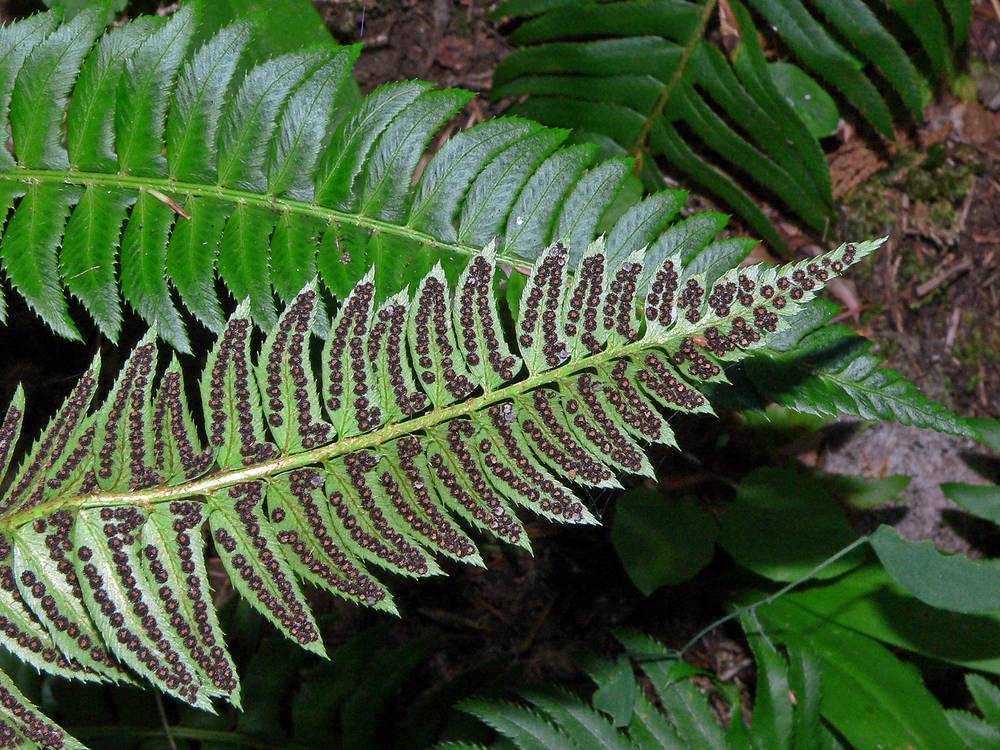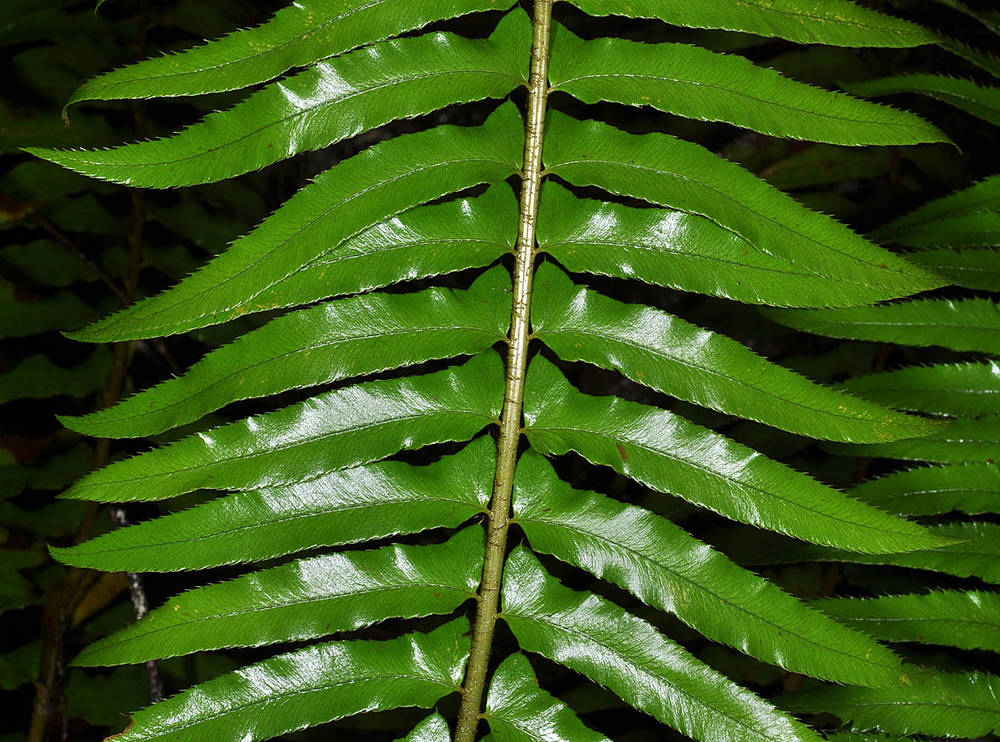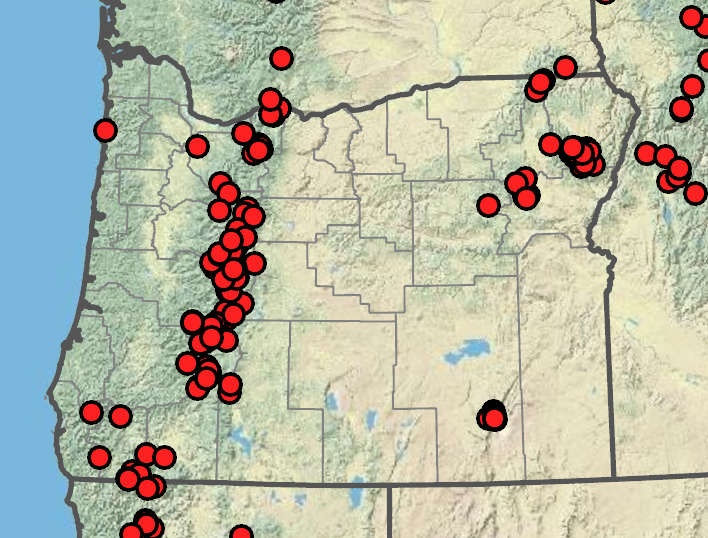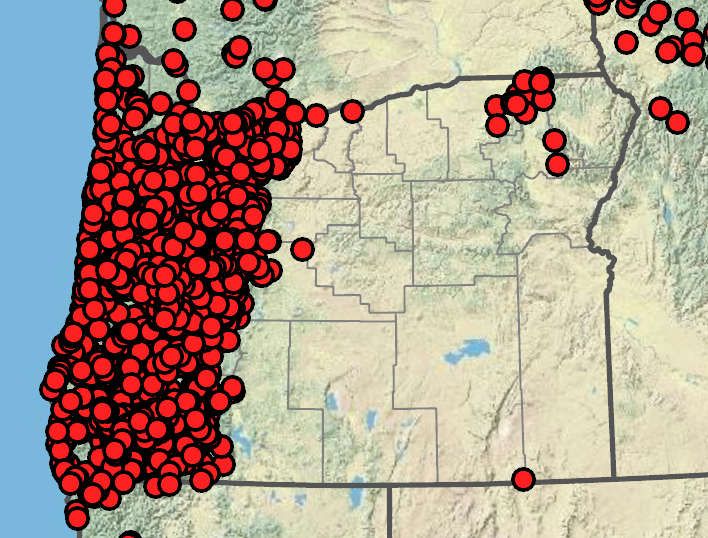Polystichum lonchitis
Polystichum munitum
Northern holly fern
common sword fern, western sword fern
erect.
typically short and erect.
to 50 cm but usually smaller, 10 cm or even shorter in specimens from exposed sites; bulbils absent.
robust; to 150 cm; in dense crowns; bulbils absent.
short; less than 20% of the leaf length;
leaves sometimes subsessile; chaffy scales sparse to dense on the petiole and rachis.
up to 25% leaf length, densely chaffy near base, becoming sparser distally; chaffy scales present along the length of the rachis and costae.
1-pinnate; very narrow; more or less linear; to approximately 45 × 5 cm; widest in the mid-region and tapered to apex and base;
microscales narrow on abaxial surface;
adaxial surface glabrous.
1-pinnate, narrowly lanceolate, tapered to the apex, not or scarcely reduced towards base;
microscales lanceolate or narrowly ovate; long-acuminate.
oblonglanceolate, slightly falcate; up to 4 × 1.5 cm; lowest pinnae often broadly triangular, rarely overlapping; in 1 plane;
margins regularly spiny-toothed;
spines conspicuous, spreading or angled forward, acroscopic auricle large, broadly triangular; ovate, bearing several spreading spines.
linear-lanceolate; to approximately 9.5 × 1 cm (above the anterior lobe), often falcate, not overlapping; in 1 plane to twisted;
margins serrulate with small, regular spine-tipped teeth; the spines bent forward and parallel to the margin, acroscopic auricle large, broadly triangular to ovate, with a prominently cuspidate apex and lateral teeth similar to those on the pinna margin.
with irregularly toothed indusia.
with fimbriate/ciliate indusial margins.
=82.
=82.
Polystichum lonchitis
Polystichum munitum
Shaded, rocky or occasionally wet places. 300–3000 m. BR, BW, Casc, ECas, Sisk. CA, ID, NV, WA; north to AK, circumboreal. Native.
Understories of moist forests, meadows, rocky sites. 0–2200 m. BW, Casc, CR, ECas, Est, Sisk, WV. CA, ID, WA; north to AK, east to SD. Native.
This species is so abundant in the Pacific Northwest that one might forget to look for other pinnate sword ferns. At higher elevations, P. lonchitis is identified by narrowing blade bases and spreading spines on the pinna margins versus scarcely reduced blade bases and incurved spines in P. munitum. On moist, sunny, rocky sites the pinnae of P. munitum may be twisted like venetian blinds, making it look much like P. imbricans ssp. imbricans. Besides the characters listed in the key, these species also differ in the distribution of chaffy scales. In P. imbricans ssp. imbricans, these are concentrated on the proximal portion of the petiole, while in P. munitum they occur all along the length of the petiole and rachis. Polystichum munitum is widely cultivated as an ornamental, and leaves are harvested from Oregon forests for sale to florists.
Duncan Thomas
Duncan Thomas
- Local floras:
BC,
CA,
OR,
WA
- Local Web sites:
CalFlora,
CalPhotos,
Flora NW,
PNW Herbaria
WildflowerSearch
iNaturalist (observations)
USDA Plants Database
- LBJ Wildflower Center
- SEINet
- Plants of the World Online
- Encyclopedia of Life
- Wikipedia
- Google Image Search
- Local floras:
BC,
CA,
OR,
WA
- Local Web sites:
CalFlora,
CalPhotos,
Flora NW,
PNW Herbaria
WildflowerSearch
iNaturalist (observations)
USDA Plants Database
- LBJ Wildflower Center
- SEINet
- Plants of the World Online
- Encyclopedia of Life
- Wikipedia
- Google Image Search





